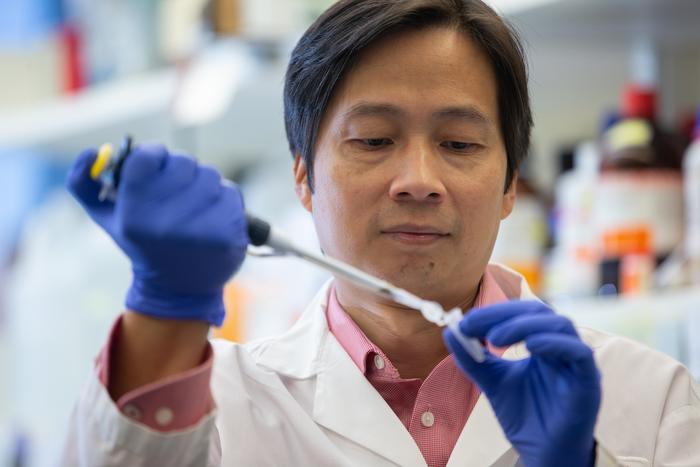
A recent investigation by the University of Cincinnati Cancer Center has unveiled groundbreaking insights into the mechanisms that underlie treatment resistance in breast cancer. The focus of the study is a specific strand of microRNA known as miR-205, which has emerged as a pivotal regulator of a protein called MED1. This protein has been identified as a significant contributor to the complex landscape of treatment resistance that affects approximately 50% of patients undergoing antiestrogen therapy, an essential treatment modality for breast cancer.
Breast cancer, a heterogeneous disease characterized by various subtypes and treatment responses, often exhibits a daunting challenge due to its propensity for treatment resistance. As antiestrogen therapies are utilized in about 75% of breast cancer cases, recurrence remains a critical concern. The research led by Dr. Xiaoting Zhang, an esteemed professor and endowed chair in the Department of Cancer Biology at UC, strives to elucidate why some tumors resist such therapies through the investigation of molecular regulators.
Central to the research is the discovery of MED1 expression, which is abnormally elevated in 40% to 60% of breast cancer cases. Previous studies have documented MED1’s role in modulating treatment responses, particularly through interactions with estrogen receptors (ERs) and HER2, a known regulator of breast cancer progression. Finding the root cause of high MED1 expression, however, necessitated an exploration into the regulatory roles played by microRNAs, including the recently characterized miR-205.
MicroRNAs are short, non-coding strands of RNA that play vital roles in genetic regulation within cells. Their function is similar to that of a dimmer switch, controlling gene activity by binding to messenger RNAs and preventing their translation into proteins. This investigation highlights the revolutionary potential inherent in understanding microRNA behavior, illustrating how these previously underappreciated molecules can significantly influence oncogenic processes.
The research team’s analyses established an inverse correlation between the levels of miR-205 and MED1. Such findings suggest that heightened activity of MED1 occurs in scenarios where miR-205 levels are decreased. Dr. Zhang notes the critical insight that if miR-205 is low, MED1 is proportionately high, thereby driving treatment-resistant phenotypes. Thus, strategies aimed at restoring miR-205 levels may pave the way for novel therapeutic approaches to counteract treatment resistance in breast cancer.
Further investigations revealed that miR-205 also regulates HER3, a member of the HER protein family known for its involvement in treatment resistance mechanisms. This dynamic interplay between miR-205, MED1, and HER3 introduces a layer of complexity to breast cancer biology. Notably, HER3 not only works alongside HER2 to promote tumor survival and proliferation but also plays a role in the activation of MED1, presenting a dual regulatory challenge for resistance management.
Despite the daunting nature of these findings, the research team is optimistic. They have embarked upon further studies utilizing in vitro human breast cancer cell lines and in vivo animal models to confirm the significance of their observations. By elucidating the functional relevance of miR-205 and considering therapeutic avenues that enhance its levels, it may be feasible to avert or mitigate treatment resistance in resistant tumor types.
Zhang envisions that these approaches could represent a paradigm shift in treatment methodologies. By leveraging innovative RNA nanotherapeutics, his startup, RNA Nanotherapeutics, is positioned to develop targeted interventions that engage the mechanistic underpinnings uncovered in this study. With previous success in patenting RNA nanoparticle technology aimed at directly addressing MED1, there is potential for adapting this scaffold to elevate miR-205 levels, providing a tailor-made solution to treatment-resistant tumors.
The forward-looking agenda incorporates utilizing patient-derived samples to test the new therapeutic strategies. This grounding in clinical relevance is paramount; patient-derived organoids and models will facilitate experimental validations more reflective of the actual tumor heterogeneity. The notable support from local foundations and the Cancer Center underscores the community’s commitment to advancing cancer research and treatment.
By meticulously examining the complexity of treatment-resistant breast tumors through the lens of microRNA regulation, this study not only brings forth pivotal clinical implications but also opens up a host of new avenues for research. Integrating microRNA dynamics into existing breast cancer therapeutic frameworks could substantially enrich the oncological arsenal.
Looking ahead, the integration of patient-derived breast cancer tissues into ongoing studies promises to yield insights of substantial clinical value. Each tumor possesses unique molecular signatures, and understanding these distinctions can guide more effective, personalized treatment paradigms for breast cancer patients. With ongoing collaboration, there is immense potential to harness local resources for broader implications in precision oncology.
As the results of this study disseminate through the scientific community, momentum will build for further exploration into microRNAs as viable therapeutic targets. This research contributes to a growing body of evidence that shifts paradigms in cancer biology, positioning non-coding RNAs like miR-205 at the forefront of breast cancer research and treatment development.
The quest to overcome treatment resistance through innovative molecular strategies continues, with the ultimate goal of providing safer and more effective therapies for patients facing breast cancer. As researchers like Dr. Zhang lead the charge, the horizon looks promising for more tailored, mechanistically informed approaches to combatting malignancies that exhibit complex, adaptive resistance.
Subject of Research: The role of miR-205 in treatment resistance in breast cancer.
Article Title: miR-205 Regulates Tamoxifen Resistance by Targeting Estrogen Receptor Coactivator MED1 in Human Breast Cancer.
News Publication Date: 28-Nov-2024
Web References: Cancers Journal Link
References: None
Image Credits: Photo/Andrew Higley/UC Marketing + Brand
Keywords: Breast cancer, Cancer treatments, MicroRNA, Cancer research, Gene targeting, Target mRNA, Cancer patients.





